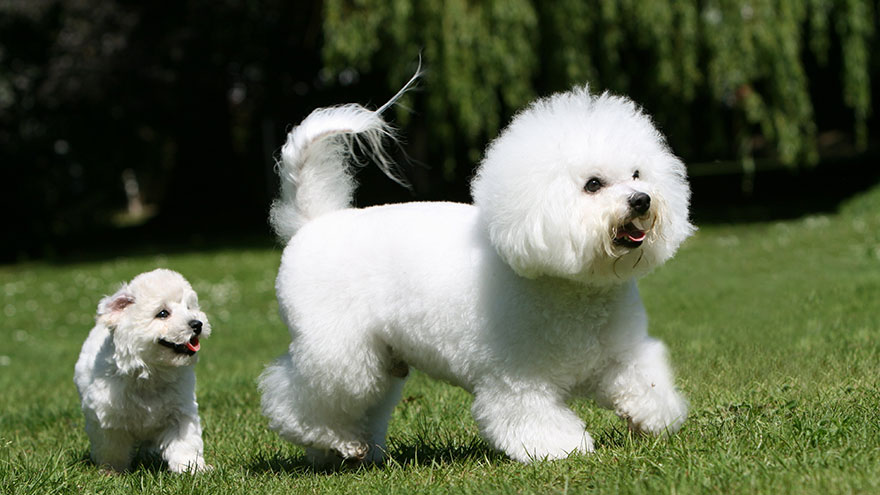About Bichon Frise Puppies
Once a pampered pet of European kings and nobles, the bichon frise now happily resides in typical American homes, where his owners still indulge in primping and grooming him.
This little puffball, whose name means “fluffy white dog” in French is smart and easy to train. He’s a popular show dog, but also an agreeable family companion.

History of the Bichon Frise
The breed wasn’t recognized by the American Kennel Club until 1972, but the bichon frise has been around for centuries. The first written account dates back to the 1300s, when French sailors brought bichon dogs back from a visit to the Canary Islands.
No one’s sure if the bichon frise originated in Spain or Italy, but the breed was popular with royal families in Europe during the 1600s. English King Henry III owned bichons and carried them in a little basket wherever he went; French and Spanish royals also owned bichons. Several paintings from the 17th century depict bow-adorned bichons with their owners.
The Bichon Breed Standard
The AKC considers the ideal height for the bichon frise between 9.5 and 11.5 inches at the shoulder. He weighs between 10 and 20 pounds. His snowy white coat is of medium length, which gives him a stuffed-animal appearance. The bichon’s hair is trimmed to accentuate the shape of his body and is slightly longer on his ears, tail and head.
It’s hard not to find the bichon adorable with his dark eyes and black eye rims that make them stand out on his all-white face. He has a short snout and a black nose. His fluffy, drop ears hang to his jawline. His equally fluffy tail is plumed and curls upward, resting on his back.
The bichon frise is part of the AKC’s non-sporting group.
Living with Your Bichon Frise
Bichons are intelligent, but need firm rules from the beginning, otherwise they can become stubborn and spoiled. While it’s easy to give in to such a sweet, fluffy face, stay firm regarding house rules. Send your bichon puppy to kindergarten; he’ll bask in the attention and exceed training expectations.
Some bichons are naturally shy and develop fear aggression, which results in snapping, growling and other naughty behavior. Socialize your puppy early. Take him to meet as many people as possible so he won’t be afraid of deep voices, beards, glasses, hats or uniforms.
Introduce him to everyday noises such as car horns, sirens, garbage trucks and other dogs barking. It’s best to carry your bichon in your arms during early socialization when he hasn’t yet had his full series of vaccinations. He may be exposed to harmful diseases if he comes into contact with other dogs or their feces.
The bichon has a double coat, which should be snowy white. To keep your pup from looking dingy, bathe him regularly. You may hear that your bichon doesn’t shed, but that’s not true. Instead of falling out onto the floor or furniture, his fine hair gets stuck in his undercoat.
If he’s not regularly brushed, your puppy’s coat will become matted and hopelessly tangled. Introduce him to his groomer early so he won’t become anxious and try to bite the hand that makes him beautiful. He’ll need regular haircuts throughout his life, along with pedicures and dental attention.
Find a Healthy Bichon Puppy
Your healthy Bichon Frise puppy can live between 16 and 18 years with proper care and nutrition. His breed is prone to a few serious conditions:
- Cushing’s disease, an excess of cortisone which causes tumors, hypertension and gastrointestinal problems.
- Patellar luxation, a condition that causes the kneecap to become dislocated, affecting the puppy’s ability to walk.
- Hip dysplasia, a malformation of the hip joint which causes pain, arthritis and difficulty moving.
To avoid these maladies, purchase your bichon frise puppy from a reputable breeder. Responsible breeders screen for known conditions and don’t breed animals who show signs of unhealthy traits.
You Might Also Like :: Bichon Frise Training Guide

